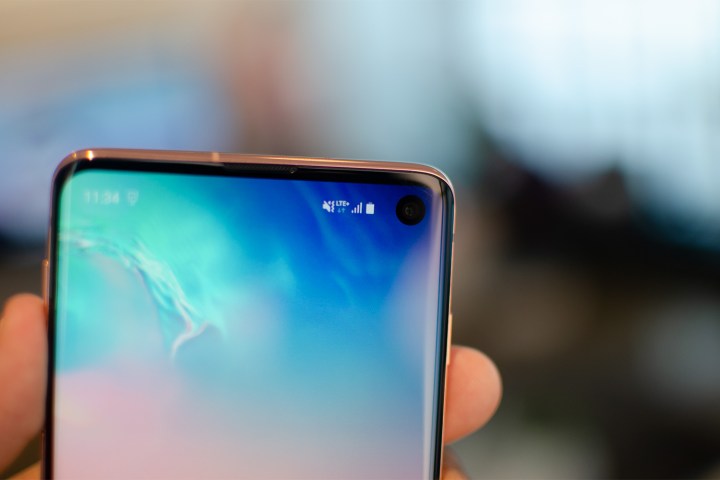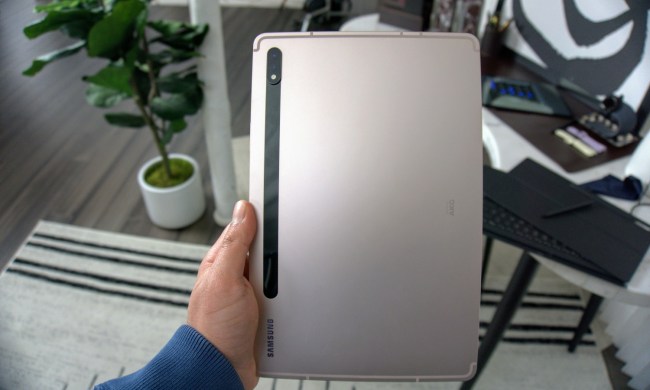There’s a steady stream of new Android phones hitting the market, but it’s always worth checking what Samsung and LG have to offer. This year is the tenth anniversary of the Galaxy S range and Samsung’s refined design hit a new level in the gorgeous and powerful S10. Compatriot and rival LG turned out the G8 ThinQ, which is equally packed with cutting edge tech and boasts a fresh hands-free gesture system.
It may prove tough to choose between these phones. Should your next smartphone be the LG G8 ThinQ or the Samsung Galaxy S10? Let’s compare them and see exactly how they differ.
Specs
| Samsung Galaxy S10 | LG G8 ThinQ | |
| Size | 149.9 x 70.4 x 7.8 mm (5.90 x 2.77 x 0.31 inches) | 151.9 × 71.8 × 8.4 mm (5.98 × 2.83 × 0.33 inches) |
| Weight | 157 grams (5.54oz) | 167 grams (5.89 ounces) |
| Screen size | 6.1-inch AMOLED | 6.1-inch AMOLED |
| Screen resolution | 3,040 x 1,440 pixels (551 pixels per inch) | 3,120 × 1,440 pixels (564 pixels per inch) |
| Operating system | Android 9.0 Pie | Android 9.0 Pie |
| Storage space | 128GB, 512GB | 128GB |
| MicroSD card slot | Yes | Yes |
| Tap-to-pay services | Google Pay, Samsung Pay | Google Pay |
| Processor | Qualcomm Snapdragon 855 | Qualcomm Snapdragon 855 |
| RAM | 8GB | 6GB |
| Camera | Triple-lens ultra wide-angle 16-megapixel, standard 12MP with OIS and variable aperture, and telephoto 12MP with OIS rear, 10MP front | Dual-lens ultra-wide-angle 16-megapixel, and standard 12MP with OIS rear, dual lens 8MP and TOF front |
| Video | 2160p at 60 frames per second, 1080p at 240 fps, 720p at 960 fps | 2160p at 60 frames per second, 1080p at 60 fps, 720p at 240 fps |
| Bluetooth version | Bluetooth 5.0 | Bluetooth 5.0 |
| Ports | USB-C, 3.5mm audio jack | USB-C, 3.5mm audio jack |
| Fingerprint sensor | Yes (in-display) | Yes (back) |
| Water resistance | IP68 | IP68 |
| Battery | 3,400mAh
Quick Charge 2.0 Qi wireless charging with Wireless Power Share |
3,500mAh
Quick Charge 3.0 Qi wireless charging |
| App marketplace | Google Play Store | Google Play Store |
| Network support | AT&T, T-Mobile, Sprint, Verizon | AT&T, T-Mobile, Sprint, Verizon |
| Colors | Prism black, prism blue, flamingo pink, prism white, prism green | Carmine red, new Aurora black, new Moroccan blue |
| Price | $900 | TBC |
| Buy from | Samsung | LG |
| Review score | 4 out of 5 stars | Hands-on |
Performance, battery life, and charging

Both of these phones have Qualcomm’s Snapdragon 855 processor inside, but neither will offer 5G connectivity — you should look at the Samsung Galaxy S10 5G or the LG V50 ThinQ for that. The Galaxy S10 has more RAM at 8GB to the G8 ThinQ’s 6GB, but we don’t think that will make much difference to your everyday experience. Both have 128GB of storage and a MicroSD card slot for expansion, though you can also get a 512GB version of the S10.
Battery size is nearly identical, but the LG G8 ThinQ has a couple of advantages with 100mAh more in the tank and support for Quick Charge 3.0 when you plug in, while Samsung sticks with the slower Quick Charge 2.0. Both also support Qi wireless charging. We can’t separate them here.
Winner: Tie
Design and durability
There are a lot of similarities between these phones in the design department, too. They are both glass front and back with gentle curves, they both have horizontally arranged camera lenses on the back, and they both have 6.1-inch screens on the front. But the Galaxy S10 adopts Samsung’s Infinity-O display, with a hole-punch camera at the top right, while the LG G8 ThinQ has a big notch for the front-facing camera. On the back, LG’s camera suite is flush under the glass, while Samsung’s sits in a clearly delineated module. LG still has a fingerprint scanner below, while Samsung has shifted it into the display. From the front, the Galaxy S10 is definitely the better-looking phone, and it’s a touch smaller and sleeker in every dimension.
With IP68 ratings, which mean both phones can take a dunk and keep on ticking, there’s no separating them on durability. Samsung takes this on the strength of its design.
Winner: Samsung Galaxy S10
Display

Once again, on paper, these phones are neck and neck with both featuring a 6.1-inch OLED screen. LG’s G8 ThinQ actually has a slightly higher resolution because it features a 19.5:9 aspect ratio, whereas the Galaxy S10 display is 19:9. This is not something you’re really going to notice. Samsung’s Dynamic AMOLED is the best display it has turned out, the brights are brighter than everyone else, the colors more vibrant, and more of the front of the phone is screen than any other phone right now. With HDR10 support and the ability to fire audio out through the screen, thanks to something LG calls Crystal Sound OLED, the G8 ThinQ’s display is no slouch. The difference here is small, but Samsung’s display is probably the best you’ll find on any phone right now, so it wins.
Winner: Samsung Galaxy S10
Camera

With a triple-lens main camera that combines a 12-megapixel lens with a variable aperture, a 12-megapixel telephoto lens, and a 16-megapixel ultra-wide-angle lens, the Galaxy S10 has a very versatile setup. You’ll be able to capture great shots in most situations, zoom in when you need to, or widen the filed of view to cram more in. The LG G8 ThinQ has a similar setup with a 12-megapixel lens, a 16-megapixel ultra wide-angle lens, and a 12-megapixel telephoto lens, but the version we tested did not have the telephoto lens and apparently, the triple-lens version will only be available in certain markets.
Around front, the Galaxy S10 has a single 10-megapixel camera, while the G8 ThinQ pairs an 8-megapixel lens with a Time-of-Flight (TOF) camera. This TOF sensor enables LG’s Z Camera feature which allows you to unlock your phone with your face or hand, and some other things we’ll get into in the special features section below.
We need more time with these phones to really assess the cameras, but going on the specs and past performance, we expect the Galaxy S10 to outperform the G8 ThinQ.
Winner: Samsung Galaxy S10
Software and updates

You’ll find Android 9.0 Pie on both these phones, but Samsung has put One UI over the top and LG has its own user interface. Samsung has been criticized for a busy UI in the past, but One UI is a big improvement and we prefer it to LG’s UI. Unfortunately, both manufacturers have a pretty poor record when it comes to software updates. We expect the S10 and G8 ThinQ to receive at least two Android version updates, but there’s no telling how long it will take or who will push an update first.
Winner: Tie
Special features

Samsung offers a lot of extras in the S10, including the desktop replacement DeX mode, Gear VR support, Samsung Pay, Bixby, Knox security, and that in-display fingerprint scanner. Also worthy of note is the reverse wireless charging function which allows you to wirelessly charge up any Qi-certified device with your Galaxy S10.
LG likes to innovate and the G8 ThinQ features the aforementioned Z Camera, with that special depth-sensing Time of Flight sensor. It allows secure face unlocking, Hand ID which scans the vein pattern in your hand, and also gestures that enable you to wave your hand above your phone and trigger different actions without actually touching it. For example, you could pause a video when you have dirty hands in the kitchen without messing up your phone.
It’s debatable how useful these extras are, some will be one-use gimmicks, while others may prove truly handy — it depends on how you use your phone and what you’re looking for.
Winner: Tie
Price and availability
The Samsung Galaxy S10 starts from $900 and you can pre-order it now for March 8 delivery. You’ll get a free pair of Galaxy Buds if you do pre-order. We don’t yet have confirmation on when the LG G8 ThinQ will be available or how much it will cost, but we suspect it will be closer to $800.
Both these phones are going to be available unlocked from a wide variety of retailers and you’ll be able to pick them up at all the major carriers.
Overall winner: Samsung Galaxy S10
This is a really close run thing. The Galaxy S10 wins because of Samsung’s elegant, refined design and a slightly better display and camera. But the LG G8 ThinQ really isn’t far behind and it may prove to be the better choice for some people, especially if it comes in at $100 less. If the S10 is at the top of your shopping list, you may also want to check out how it compares to the rest of Samsung’s new lineup.




